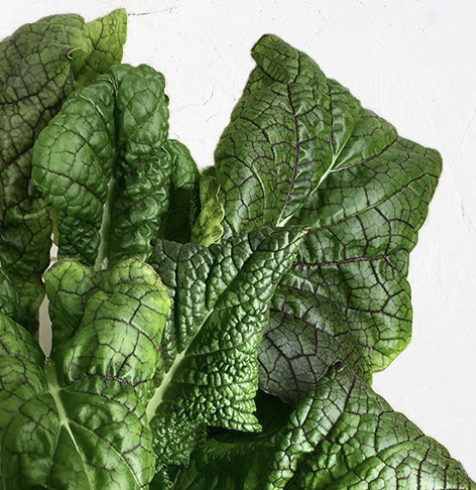Red Mustard
Latin name: Brassica juncea
🌱 Days to Sprout: 5-21
😋 Ready for Full Dose of plant food with true leaves or roots .5-inch long
✂️ Thin to: 1 plant per yCube
🍅 Days to Maturity: 21-45
💡 Light Zone: Medium
📏 Plant Size: <1 ft
💚 Care Level: Beginner
Origin
Red Mustard is thought to have originated in the Central Asian Himalayas before spreading to China, India, and the Caucasus. Red Mustard is part of a family of cruciferous vegetables that includes cabbage, broccoli, and kale.
Qualities
Red Mustard leaves are a beautiful deep green with red veins. Mature leaves may also take on a reddish hue. Mustard leaves are an excellent source of vitamins C and E, fiber, folate, calcium, iron, magnesium, potassium, and B6. The calcium in mustard leaves ranks among the highest in bioavailability. Similar to other plants in the Brassica genus, the sulfur-containing glucosinolate compounds in Red Mustard have potent anti-cancer and health-promoting properties.
Use
Red mustard leaves have a spicy, peppery flavor. Mature leaves can be eaten raw, boiled, sautéed, steamed, or braised. The longer they are cooked, the softer the flavor becomes, but keep in mind that their health-promoting glucosinolate compounds are also reduced as cooking time increases. Baby mustard greens can be eaten raw in salads or sandwiches.
Care & Harvest
💡Temperature: Prefers cooler temperatures (60-70°F), and if placed in higher temperatures, it will turn bitter and bolt.
✂️ Pruning: Check the roots monthly and trim any that are brown or extending past the yPod. To delay bolting, cut yellow-flowering stems as they appear.
🔎 Plant Health: Aphids are a common pest, but you can use our prevention tricks to keep pests at bay!
🥬 Harvest: Younger leaves tend to have better flavor and texture than more mature leaves. For ongoing harvest, snip the outer leaves just above the base of the plant once they reach 2-3 inches tall to let the inner leaves continue to grow. Leave 1/3 of the plant if you want it to keep growing. To harvest the full head, wait until it reaches maturity, then harvest from the base.
Harvest To Plate Recipe
Asian-Inspired Mustard Greens
Recipe Source: Allrecipes
Ingredients
1 tablespoon sesame seeds (Optional)
1 teaspoon Asian (toasted) sesame oil
6 cups washed and chopped mustard greens
¼ cup water
1 teaspoon minced garlic, or to taste
1 tablespoon soy sauce
2 teaspoons Japanese rice wine (mirin) vinegar
1 teaspoon sake (Optional)
1 teaspoon white sugar
Instructions
Place the sesame seeds into a large skillet over medium heat. Cook, stirring constantly, until the seeds are toasted golden brown and make a continuous crackling noise, 1 to 2 minutes. Transfer the seeds immediately to a bowl to stop the cooking process. Set seeds aside.
Place sesame oil in the hot skillet, and heat until it just begins to smoke (this should happen very fast).
Place mustard greens into the hot oil, and pour in water. With a spatula, gently toss the greens until they are wilted and reduced in quantity, about 2 minutes.
Mix in garlic, soy sauce, rice wine vinegar, sake, and sugar.
Bring the mixture to a boil, stir until sugar has dissolved, and cover the skillet.
Reduce heat to a simmer, and cook until the greens are tender, 10 to 15 minutes. If a thicker sauce is desired, remove greens with a slotted spoon, and cook the liquid down to desired thickness; return greens to the skillet, toss in the pan juices, and sprinkle with toasted sesame seeds to serve.
Our Plant Health & Nutrition Team thoroughly tests each variety we offer to bring you the most flavorful and high-quality plants. We regularly rotate our plant portfolio, so please note, availability varies.

